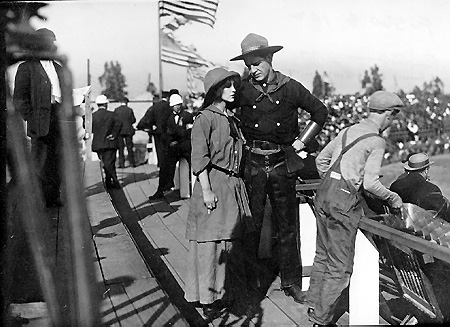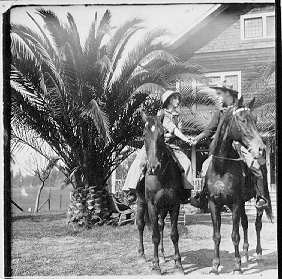 Volume II: Filmography
Volume II: Filmography Volume II: Filmography
Volume II: Filmography


Production stills with Florence LaBadie and William Russell. Courtesy of the Academy of Motion Picture Arts and Sciences. (F-560-1 & F-560-2)
March 21, 1913 (Friday)
Length: 1 reel
Character: Drama
Director: Lucius J. Henderson
Cameraman: Arthur A. Cadwell
Cast: Florence LaBadie (the cowgirl), William Russell (leading man)
Location: Southern California
Note: In his The Educational Picture column in The Moving Picture World, April 26, 1913, Rev. E. Boudinot Stockton recommended this film as an agricultural subject.
SYNOPSIS, The Moving Picture World, March 22, 1913:
The proprietor of a hotel in a little California town sent his motherless daughter to a boarding school, being determined that she should have every advantage he could afford. He did not regret it, for when she returned she had no foolish notions, but settled down and aided him in his work. When he had difficulty in securing help, the girl insisted upon taking charge of the dining room, and the old man confided to his chums that she was the best headwaitress he ever had. The girl was fond of horseback riding and enjoyed dashes along the country roads. On one occasion, however, she nearly came to grief, for her nag ran away. A gallant cowboy came to her rescue, overtook the frightened animal, and prevented any harm coming to the young woman. Naturally a friendship sprang up between the two, for each saw much in the other to respect and admire.
In that section of the country there is annually held what is called a 'Rodeo,' a contest of horsemanship, with all sorts of Wild West features. The cowboy was a dashing rider, and on the day of the entertainment told the girl he was absolutely sure to win the prize. Their conversation took place in the dining room of the hotel, and as he passed out she noticed two incoming guests who seemed to take much furtive interest in the young man. She watched them narrowly, learned enough to arouse her suspicions and, obeying a sudden impulse, followed them when they left the hotel. From a place of hiding she learned that they were gamblers, who bet heavily against her cowboy, and to insure winning their wagers had planned to cripple the horse just before the race started. The girl determined to warn the young man, rode all alone to the arena, and was in time to foil the plotters. Her cowboy won the prize, but on the way home he won something he valued far more, the hand and heart of the girl who had proven her quick wit in the hour of need.
REVIEW, The Moving Picture World, March 29, 1913:
We cannot remember every having seen a more successful exposition of real bronco busting than is shown in this lively reel. It certainly gives us the genuine article, both men and girl riders competing in the rodeo. It is worth the price of admission to the average picture show to see this film. A fine offering.
REVIEW, The Moving Picture News, March 22, 1913:
Most satisfactory. This film exhibits plenty of action, with natural and consistent development. There is a breeziness to the plot and detail to the story, as produced by Thanhouser. It carries the interest of the onlooker along with it. Some thrilling scenes of bucking broncos and their riders are shown in the development of the story.
REVIEW, The New York Dramatic Mirror, March 19, 1913: This review is reprinted in the narrative section of the present work.
# # #
Copyright © 1995 Q. David Bowers. All Rights Reserved.